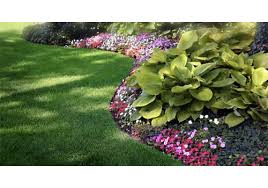Grass without the Work? It’s Possible
Thursday, May 19th, 2016Is there really and truly such as thing as a maintenance-free lawn?
Probably not. So instead let’s consider reducing the amount of maintenance on our yards because that is definitely doable.
Lawns are labour intensive and resource hungry. According to Sheridan Nurseries, to have great grass you need to water, mow, fertilize, control weeds, bugs, thatch, aerate and seed. The list is exhausting.
But there are ways to control the amount of time, money and resources spent on lawns by shrinking their size. Consider using low-maintenance ground cover in spots that are shady such as under mature trees. Replacing grass with gravel along the side of the house where it’s always shady will go much easier on your back than reseeding every year and engaging in a losing battle to have green turf where it’s not really suitable.
Wider flower beds filled with shrubs, evergreens and ground covers will help reduce the size of your lawn. Small lawns can be completely replaced with stone, paths, birdbaths and benches in addition to a number of slow-growing and drought-resistant plants.

Of course, there’s always artificial turf, paving and rock gardens and drought-tolerant grasses that look like the real deal but need far less water and maintenance.
One of the first things you’ll need to do when moving to a low-maintenance lawn lifestyle is learn to chill. If you are used to high-maintenance yards in which every blade of grass stands at attention and all of your time, considerable resources and expense are exerted to get it just so, you will need to make an attitude adjustment. Know that what you are doing is good for the environment and your peace of mind.
In fact, the Canada Housing and Mortgage Corporation conducted a study in 1998 and 1999 on different residential landscape types. The study compared the maintenance of five conventional lawns with four low-maintenance ones. Residents with low-maintenance lawns spent 50 per cent less time, 85 per cent less money, and used 50 per cent less fuel, 85 per cent less fertilizer, 100 per cent less water and 100 per cent less pesticides per year than residents with conventional lawns.
The first thing you need to do to get a low-maintenance lawn is select a diversity of lawn species that are hardier and more drought tolerant. While there is no sure-fire formula for the best low-maintenance lawn mix, the CMHC recommends a general guideline of 40 per cent fescues, 40 per cent other grasses and 20 per cent broadleaf species.
It is possible to convert a high-maintenance lawn to low. The first thing you need to do is expose as much bare soil as you can by raking it. Top it with compost and overseed with low-maintenance lawn species and water. You may have to overseed every year for as many as three years, depending on your type of existing grass.
If that’s too long for you, you can strip off your existing lawn. Or try mowing it really close and then covering it with a thick black plastic sheet held down with rocks. Leave the plastic on for two months. Remove the sheet and dig the dead grass into the soil. Your lawn is now ready for seeding for sodding.
